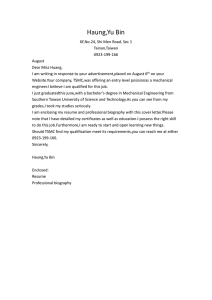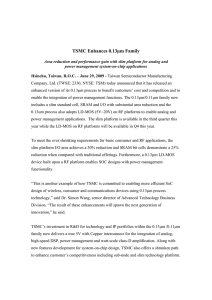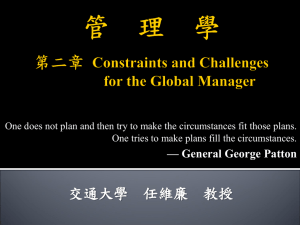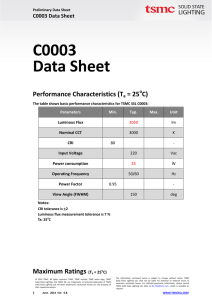4.2 Environmental, Safety, and Health (ESH) Standards
advertisement
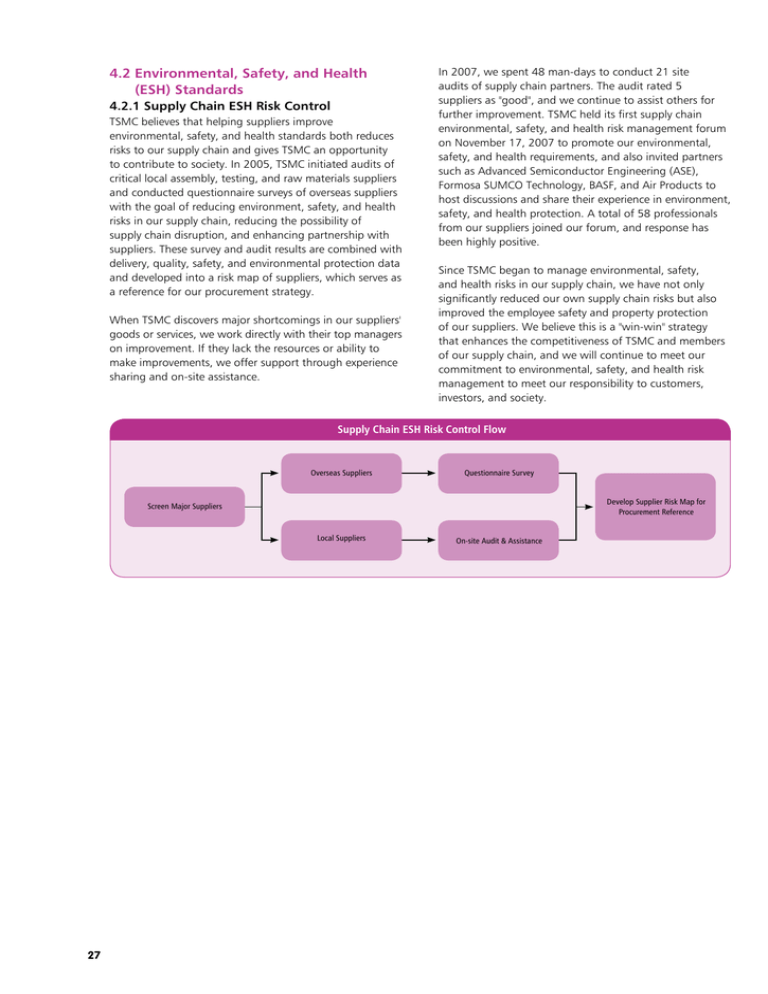
4.2 E nvironmental, Safety, and Health (ESH) Standards 4.2.1 Supply Chain ESH Risk Control TSMC believes that helping suppliers improve environmental, safety, and health standards both reduces risks to our supply chain and gives TSMC an opportunity to contribute to society. In 2005, TSMC initiated audits of critical local assembly, testing, and raw materials suppliers and conducted questionnaire surveys of overseas suppliers with the goal of reducing environment, safety, and health risks in our supply chain, reducing the possibility of supply chain disruption, and enhancing partnership with suppliers. These survey and audit results are combined with delivery, quality, safety, and environmental protection data and developed into a risk map of suppliers, which serves as a reference for our procurement strategy. When TSMC discovers major shortcomings in our suppliers' goods or services, we work directly with their top managers on improvement. If they lack the resources or ability to make improvements, we offer support through experience sharing and on-site assistance. In 2007, we spent 48 man-days to conduct 21 site audits of supply chain partners. The audit rated 5 suppliers as "good", and we continue to assist others for further improvement. TSMC held its first supply chain environmental, safety, and health risk management forum on November 17, 2007 to promote our environmental, safety, and health requirements, and also invited partners such as Advanced Semiconductor Engineering (ASE), Formosa SUMCO Technology, BASF, and Air Products to host discussions and share their experience in environment, safety, and health protection. A total of 58 professionals from our suppliers joined our forum, and response has been highly positive. Since TSMC began to manage environmental, safety, and health risks in our supply chain, we have not only significantly reduced our own supply chain risks but also improved the employee safety and property protection of our suppliers. We believe this is a "win-win" strategy that enhances the competitiveness of TSMC and members of our supply chain, and we will continue to meet our commitment to environmental, safety, and health risk management to meet our responsibility to customers, investors, and society. Supply Chain ESH Risk Control Flow Overseas Suppliers Questionnaire Survey Develop Supplier Risk Map for Procurement Reference Screen Major Suppliers Local Suppliers 27 On-site Audit & Assistance 4.2.2 S upplier Annual Emergency Response Drill One of our chemical suppliers, BASF, held its annual emergency response drill on December 2007, and TSMC was invited to act as observers at BASF's headquarters in Taipei, its Taoyuan plant, and the simulated accident site. This cooperation through exchange of professional experience marked a closer partnership relationship with our suppliers. TSMC's major gas suppliers visited its fab for experience sharing. 4.2.3 TSMC Green Supply Chain TSMC not only strives to prevent pollution, conserve energy and resources, and minimize waste and hazardous substances in its own manufacturing processes, but also actively leads its upstream raw material suppliers and downstream assembly and testing facilities to establish a green supply chain, collaborating to improve environmental and carbon reduction performance of products. We implement our green supply chain from a product life cycle point of view to reduce the environmental impact of manufacturing at each stage of the supply chain and minimize the environmental impact of end-products used by consumers. Beginning in 2005, TSMC has conducted questionnaire surveys and site audits of major domestic and international raw materials suppliers and international assembly and testing facilities. Environmental protection and hazardous materials reduction are a key part of the audits and surveys, which are combined with delivery, quality, and service data to develop a supplier risk profile, an important reference for TSMC's procurement policy. In the past, corporations focused on waste disposal, pollution prevention, and energy conservation in manufacturing process, relying on the ISO14001 environmental management system. However, even if waste and pollutants generated by production are treated properly, the product itself may have environmental impact. The "green product" concept begins with products used in daily life to set environmental requirements on products. The European Union has led the way by restricting imports of electric and electronic products containing lead, cadmium, mercury, hexavalent chromium, PBB, and PBDE, requiring recycling of waste electrical and electronic equipment. As a leader in semiconductor manufacturing and services, and to meet our corporate social responsibilities, TSMC began to implement the QC080000 hazardous substances process management system in 2005, and all TSMC fabs including WaferTech and TSMC Shanghai were certified for QC080000 by July 2007. In addition, TSMC has also shared its QC080000 policies and experience with affiliated companies, and one affiliate, Vanguard International Semiconductor, received QC080000 certification in June 2007. TSMC's leadership in guiding upstream supply chain partners and downstream companies to adopt QC080000 demonstrates TSMC's willingness to take action and improve the semiconductor industry's environmental social responsibility. Our next goal will be to embed the "green product" concept in all suppliers and assembly and testing subcontractors. 4.3 Managing Contractors' ESH TSMC endeavors to be a good enterprise citizen and meet its corporate social responsibilities, TSMC believes in going beyond providing a safe workspace for employees to establish a higher ESH standard with our partners in all industries. TSMC is committed to communicating with suppliers and contractors on environmental, safety, and health issues and encouraging them to improve their ESH performance. TSMC treats contractors like our employees and works together with them to adopt good safety protection, and leads members of our supply chain to reduce their environmental impact. 28
